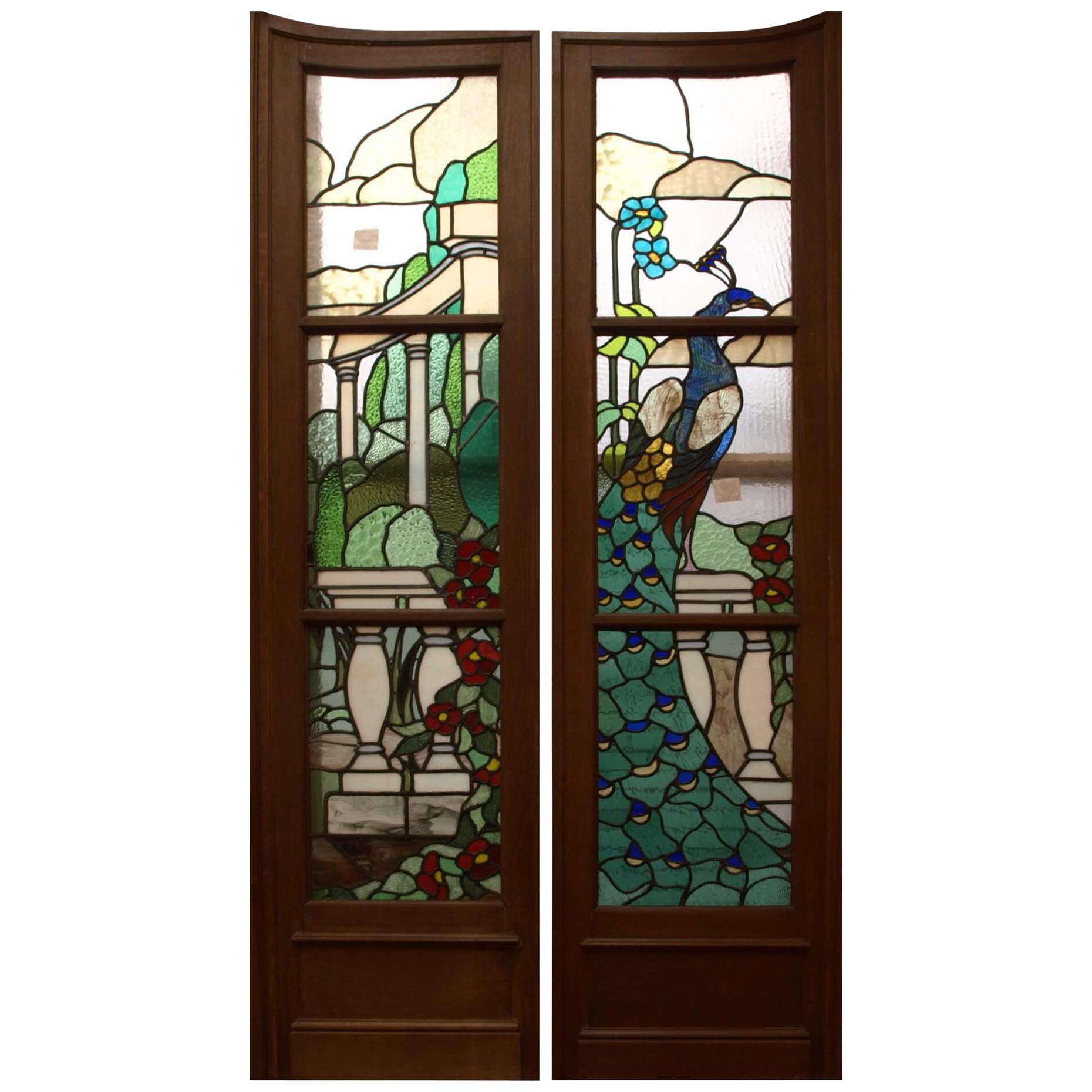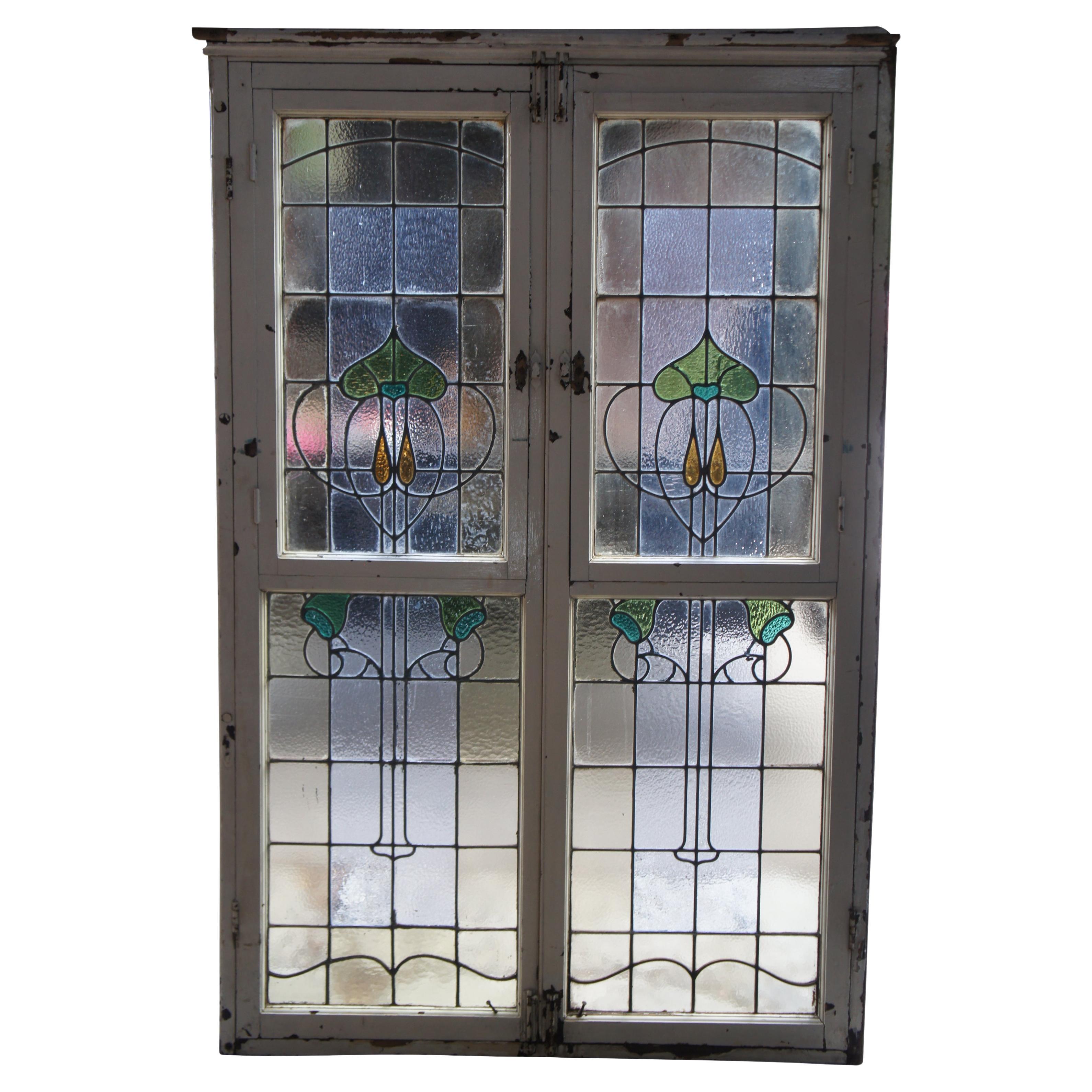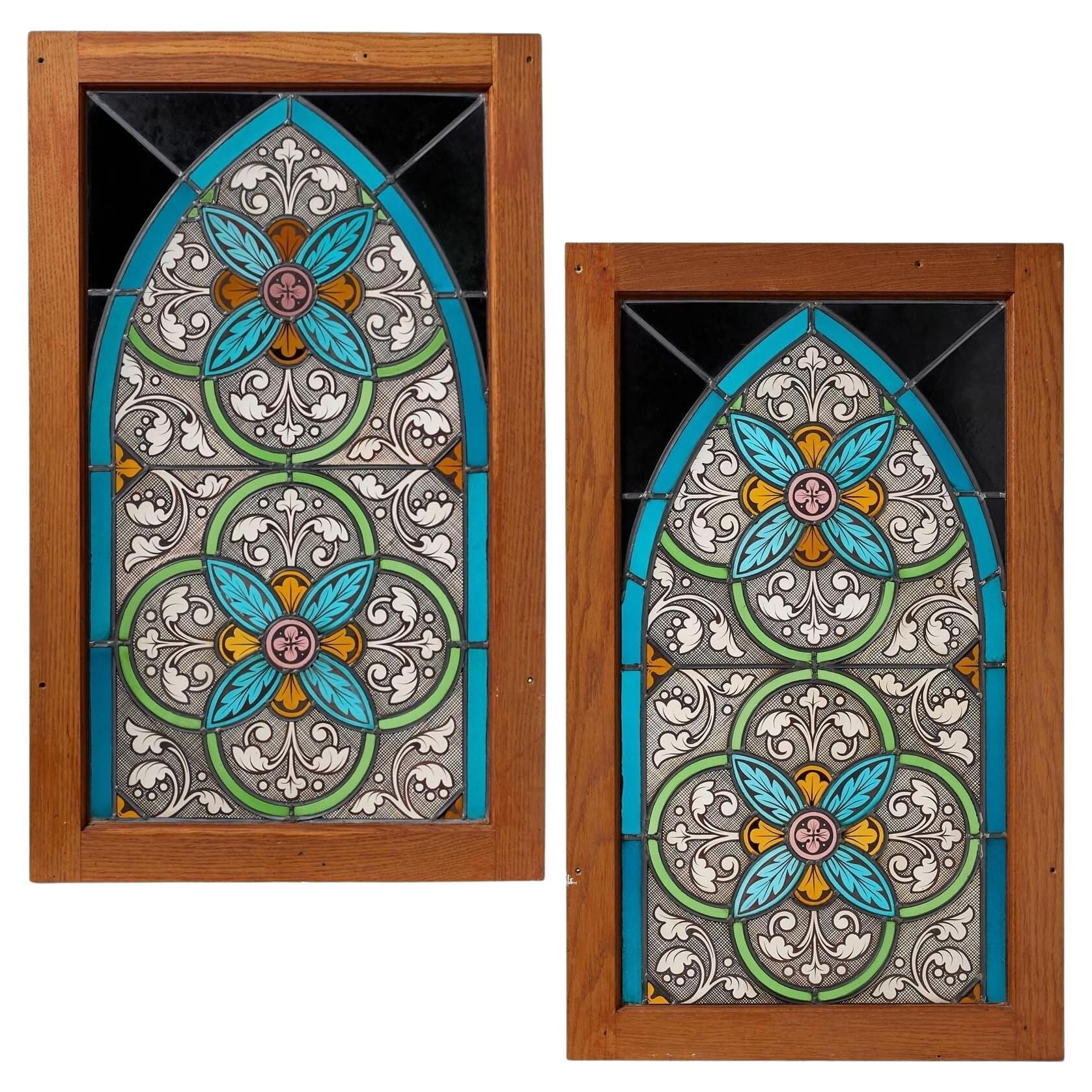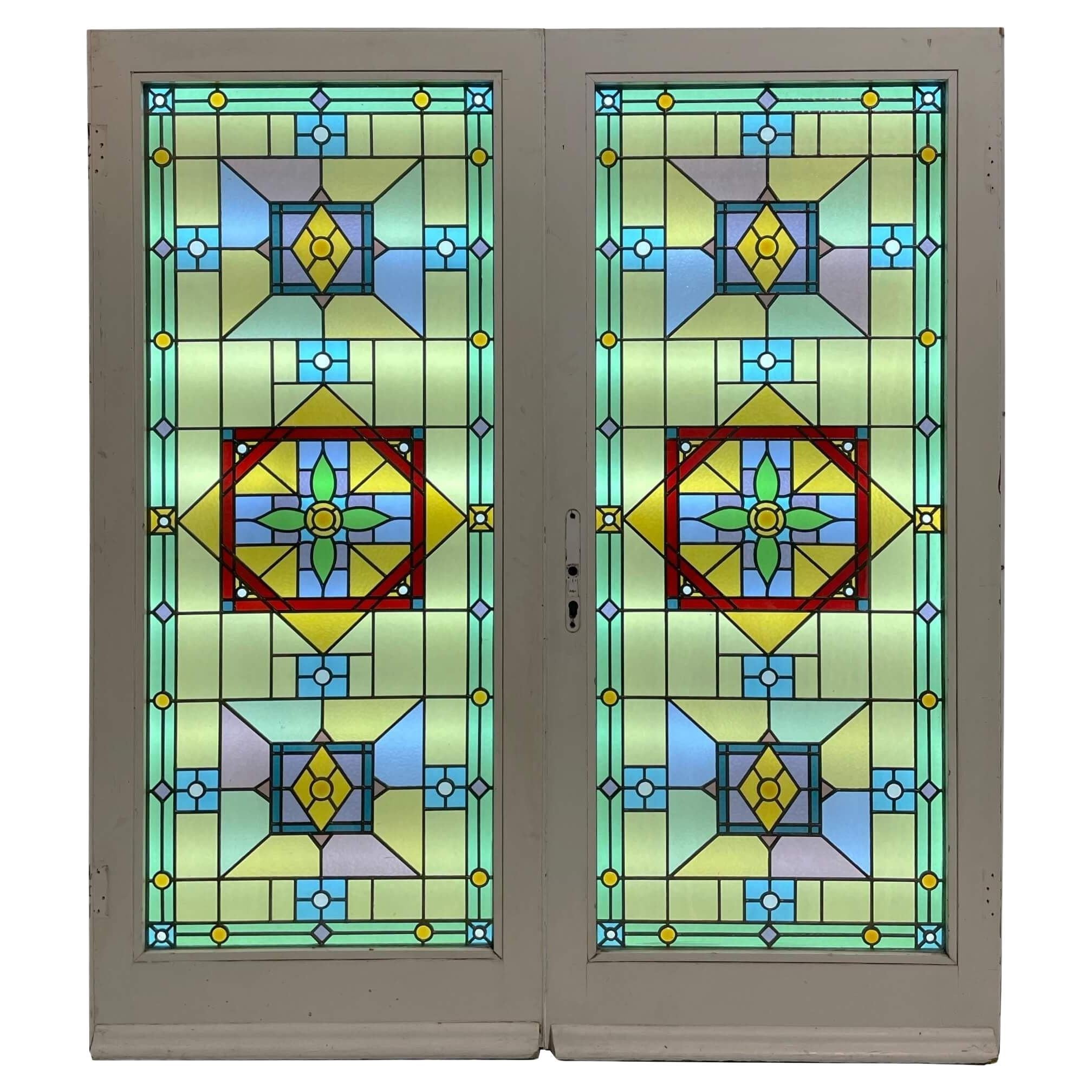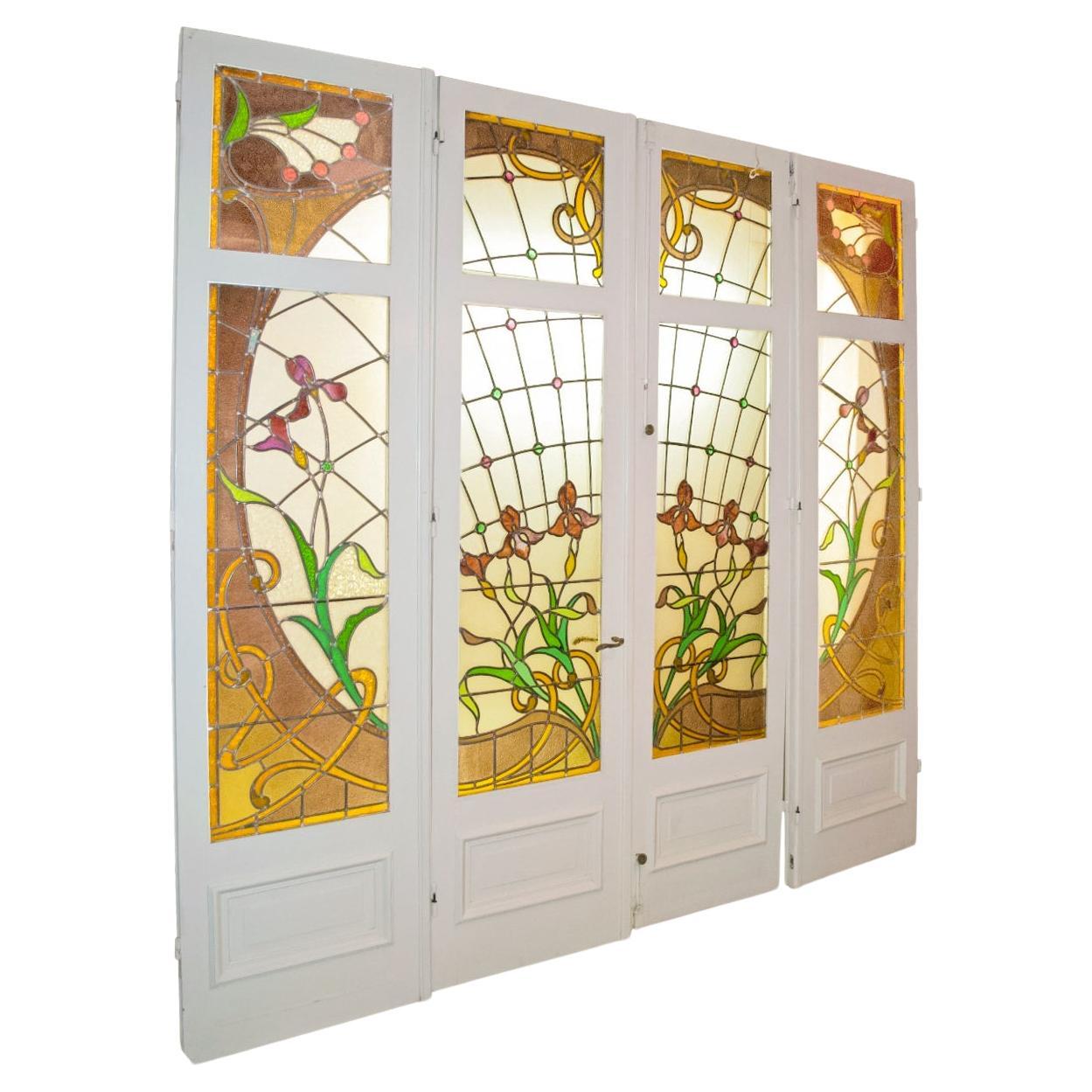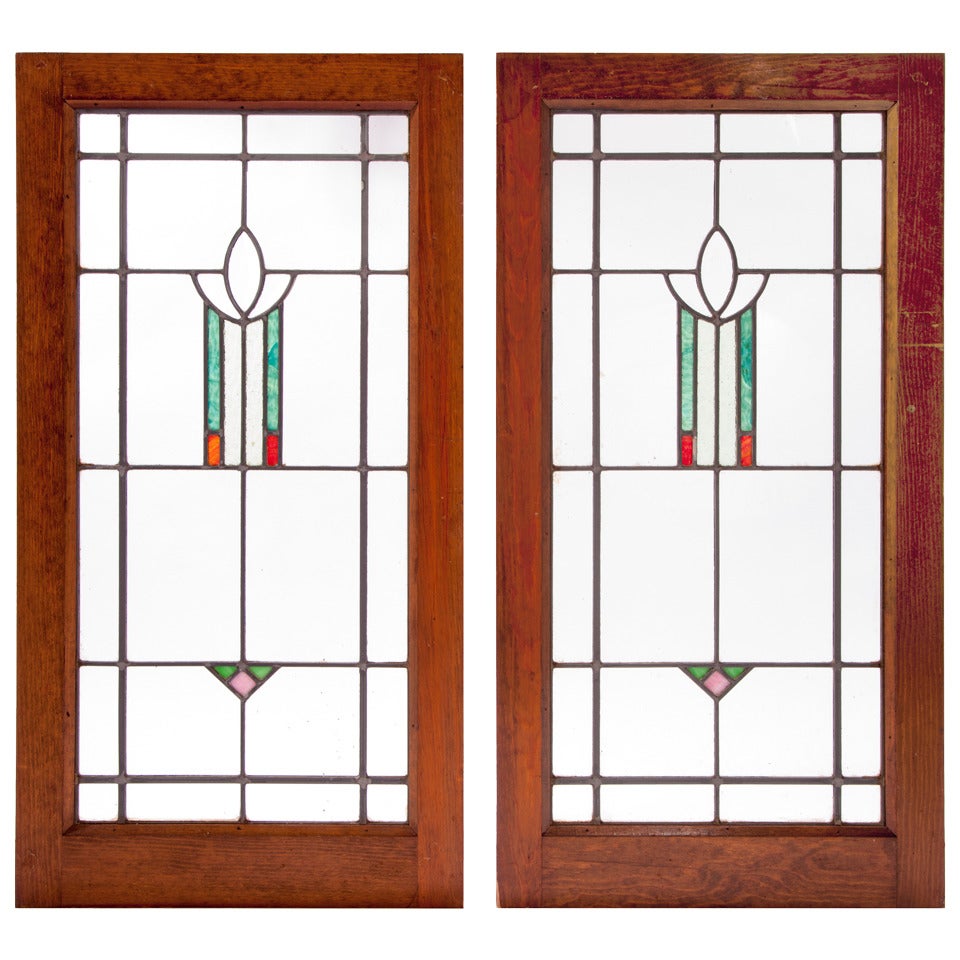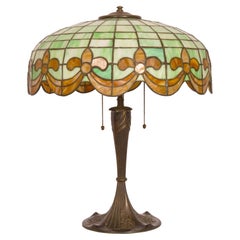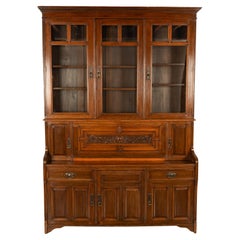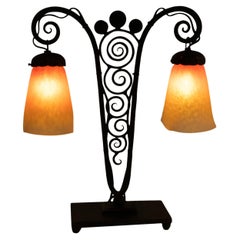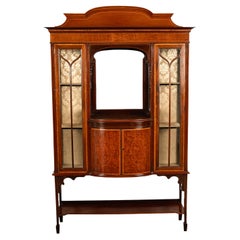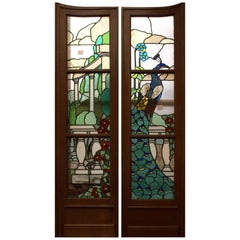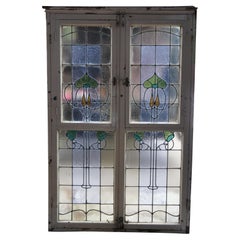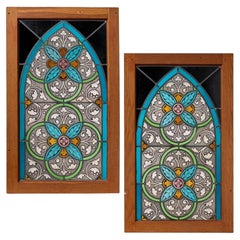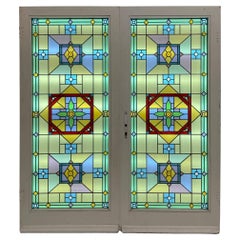Items Similar to Pair Antique American Stained Glass Gothic Art Nouveau Doors Windows Povey Bros
Want more images or videos?
Request additional images or videos from the seller
1 of 12
Pair Antique American Stained Glass Gothic Art Nouveau Doors Windows Povey Bros
$11,995
£9,045.42
€10,461.46
CA$16,828.92
A$18,706.39
CHF 9,805.49
MX$228,450.30
NOK 122,415.88
SEK 115,170.50
DKK 78,081.32
About the Item
A rare & important pair of antique American Art Nouveau with Gothic frames stained glass doors/windows, by Povey Brothers, Portland Oregon, circa 1900. Over 6.5' in height.
Povey Brothers were the preeminent stained glass makers located in Portland Oregon, they produced stained glass to rival that of Louis Comfort Tiffany, please see their biography below. This important pair of stained and leaded glass doors/windows are quintessentially in the Art Nouveau style with sinuous organic floral designs, the windows are housed in the original gothic arch frames. The glass is a mixture of Kokomo, rippled and textured glass, all the leading is tight and remarkably there are no cracked panes or damage. These doors were most likely for a residential project with the absence of any ecclesiastical design, By family repute were confirmed as being produced by Povey Bros by the architect & daughter of David Lincoln Povey, Polly Povey Thompson. The images show the doors with both natural light filtering through and also without natural light coming through,
condition is excellent, a fine & rare pair of antique Art Nouveau stained glass doors/windows by The Povey Brothers, circa 1900.
Povey Brothers Studio, also known as Povey Brothers Art Glass Works or Povey Bros. Glass Co., was an American producer of stained glass windows based in Portland, Oregon. The studio was active from 1888 to 1928. As the largest and best known art glass company in Oregon, it produced windows for homes, churches, and commercial buildings throughout the West. When the firm was founded in 1888, it was the only creative window firm in Portland,
Povey Brothers was known as the "Tiffany of the Northwest" and many of the company's windows still exist in historic buildings throughout the region, including those on the National Register of Historic Places.
The windows were considered to have extraordinary quality and beauty, and the firm's work was virtually unequaled in the Pacific Northwest. The heyday of Povey Brothers coincided with the growing economic affluence of the region, and the brothers' work was much sought after by the new rich to decorate the large houses they were building. Of this sort of installation, art glass expert Michael Mc Cary said, "People who put in that kind of glass were kind of showing off." The Great Depression and changes in house styles eventually caused demand for the brothers' work to decline, however. Today Povey Brothers windows are a mark of pride in many landmark buildings in Portland
The company was founded by David Lincoln Povey, the son of English-born stained glass window maker Joseph Povey, who immigrated to the United States in 1848 and subsequently worked in stained glass in Philadelphia, New York City, and Newark, New Jersey. The family, who had been in the stained glass trade for generations, eventually settled in St. Louis, Missouri. David Povey was born in 1865. He studied art at Cooper Union in New York and traveled in Europe for further study before moving to Portland. David formed the glass company in 1888 with his brother John, shortly after working on a commission for First Presbyterian Church. The company incorporated in 1893. John was the main craftsman and did the glazing and leading, while David did the design and art work. Their brother George Povey later joined the company as its accountant and business manager, and two Povey sisters also worked for the company. All three of the brothers worked in various glass studios on the East Coast before establishing their Portland shop. At the height of their business, the brothers employed 25 workers, including several Povey family members. David died in 1924 and his sons David and Darrel took over the business. In 1925, they hired Albert Gerlach, formerly of Giannini & Hilgart in Chicago and trained at the Art Institute of Chicago, to assist in the business. The Povey Brothers sold the company to W. P. Fuller in 1930, and Gerlach remained at the company until 1950.
John Povey died in 1917. His Queen Anne Victorian home in the Irvington neighborhood, the John E. G. Povey House, is listed on the National Register of Historic Places.
David Povey's daughter, Portland architect Polly Povey Thompson, had planned to write a book on her father's works, but she died in 1994 before it could be completed. Povey windows continue to be documented. George Povey's granddaughter, Laurie Povey Crawford, of Everett, Washington, did not know that the First Presbyterian Church in Everett held Povey windows until 2015
The brothers imported their glass from Europe, but designed and constructed their windows in Portland. They often used opalescent glass in their work, a style that John La Farge and Louis Tiffany had pioneered in the 1870s. Their church windows were done in a Classical style often based on famous religious paintings, such as those by Raphael, and had images or scenes painted on non-opalescent glass. They were also noted for their use of "jewels", small, thickly cut faceted pieces of glass in rich colors, and for several other types and textures of glass, including Kokomo, crackle, rippled, granite-textured, and machine-rolled. The studio's early residential work was colorful and ornate, often using Art Nouveau motifs, and later work was influenced by the Arts and Crafts Movement. Popular motifs included grape clusters, roses, lilies, birds, and dogwood, which became a signature of the company. Another notable feature of the studio's work was the use of clear glass in the background to allow light to pass through the windows on the Northwest's typically overcast days.
Besides windows, the company also designed other glass products, including light fixtures that had a horizontal Prairie School design influence.
The studio was known for using the latest equipment and trade techniques, and for working with architects and homeowners to create unique designs that set the Poveys apart. David Povey, who developed a distinct style, designed virtually every window that left the studio. While the company's residential work was often small in scale, its church installations could be quite massive, with multiple panels.
Most Povey windows are not signed, which led to imitators passing off their work as the Poveys'. It also makes the Poveys' work difficult to identify. In 1923, David Povey began signing the widows with "Povey Brothers Studio" and the year of completion. This may have first been done for the windows of the First Christian Church in Portland, and the last such signatures may have been on the windows of Atkinson Memorial Church in 1924, the year David died.
By 1889, the Povey Brothers Studio was located in the Phoenix Building at 124 SW Ash Street in Portland. The building is a contributing property in the Skidmore/Old Town Historic District.
In 1905, the company relocated to the Povey Building at 408 NW 5th Avenue in Portland, designed for them by architect Emil Schacht. The company was still located there in 1926. The Povey Building is a contributing property to the Portland New Chinatown/Japantown Historic District.
- Similar to:Louis Comfort Tiffany (Maker)
- Dimensions:Height: 78.75 in (200.03 cm)Width: 56.5 in (143.51 cm)Depth: 4.5 in (11.43 cm)
- Style:Art Nouveau (Of the Period)
- Materials and Techniques:
- Place of Origin:
- Period:1900-1909
- Date of Manufacture:circa 1900
- Condition:Wear consistent with age and use. Very good condition.
- Seller Location:Portland, OR
- Reference Number:1stDibs: LU4876140944802
About the Seller
5.0
Platinum Seller
Premium sellers with a 4.7+ rating and 24-hour response times
Established in 2000
1stDibs seller since 2019
420 sales on 1stDibs
Typical response time: <1 hour
- ShippingRetrieving quote...Shipping from: Portland, OR
- Return Policy
Authenticity Guarantee
In the unlikely event there’s an issue with an item’s authenticity, contact us within 1 year for a full refund. DetailsMoney-Back Guarantee
If your item is not as described, is damaged in transit, or does not arrive, contact us within 7 days for a full refund. Details24-Hour Cancellation
You have a 24-hour grace period in which to reconsider your purchase, with no questions asked.Vetted Professional Sellers
Our world-class sellers must adhere to strict standards for service and quality, maintaining the integrity of our listings.Price-Match Guarantee
If you find that a seller listed the same item for a lower price elsewhere, we’ll match it.Trusted Global Delivery
Our best-in-class carrier network provides specialized shipping options worldwide, including custom delivery.More From This Seller
View AllAntique American Art Nouveau Bronze & Leaded Glass Table Lamp by Wilkinson, 1910
By Wilkinsons
Located in Portland, OR
Antique American bronze and leaded glass table lamp by Wilkinson, circa 1910.
The three light lamp having a dome shaped shade with striated leaded glass green & ivory tiles and havin...
Category
Vintage 1910s American Art Nouveau Table Lamps
Materials
Bronze
$2,625 Sale Price
25% Off
Antique Victorian Art Nouveau Carved Oak Secretary Bookcase Bibliotheque 1890
Located in Portland, OR
A fine & large antique Art Nouveau carved oak combination bookcase secretary/desk, 1890.
The two part bookcase secretary with a stepped crown to the top section with three glazed doo...
Category
Antique 1890s English Art Nouveau Bookcases
Materials
Oak
Antique French Art Deco Charles Schneider Art Glass Edgar Brandt Iron Lamp 1920
By Charles Schneider, Edgar Brandt
Located in Portland, OR
A very stylish French antique art glass & wrought iron Art Deco lamp, by Charles Schneider & Edgar Brandt, signed, circa 1920.
This origina...
Category
Vintage 1920s French Art Deco Table Lamps
Materials
Wrought Iron
Antique Sheraton Regency Revival Inlaid Display Case China Cabinet Hutch 1900
Located in Portland, OR
A very fine & elegant antique inlaid mahogany Edwardian Sheraton, Regency Revival china cabinet, hutch, circa 1900.
The cabinet having an inlaid arched gallery to the top, the cabine...
Category
Antique Early 1900s English Regency Revival Cabinets
Materials
Mirror, Mahogany, Satinwood
Antique French Galle Style Muller Freres Cameo Art Glass Landscape Table Lamp
By Muller Frères
Located in Portland, OR
A fine antique original, authentic, Art Nouveau French cameo glass table lamp, signed Muller Freres, circa 1900.
Established in Lunéville, France, Muller Frères consisted of a group ...
Category
Antique Early 1900s French Art Nouveau Table Lamps
Materials
Art Glass
Antique 19th Century Inlaid Mahogany Regency Revival Display China Hutch 1890
Located in Portland, OR
A fine antique late 19th century Regency Revival inlaid mahogany china hutch cabinet in excellent condition, circa 1890.
The cabinet of serpentine shape including the glass panels, t...
Category
Antique Late 19th Century English Regency Revival Vitrines
Materials
Mahogany, Satin, Glass, Ebony, Satinwood
You May Also Like
Pair of Early 20th Century Stained Glass Doors
Located in London, GB
Pair of early 20th century stained glass doors
Continental, early 20th century
Each door: Height 239cm, width 59cm (118cm when together), depth 9cm
T...
Category
Early 20th Century European Aesthetic Movement Doors and Gates
Materials
Stained Glass, Wood
$16,555 Sale Price / set
20% Off
Monumental Antique Victorian Art Nouveau Leaded Stained Glass Window French Door
Located in Dayton, OH
A rare and exceptional reclaimed large two part leaded stained glass French Door / Window. Features a large rectangular frame with two 2-part hinged doors with separate operating win...
Category
Antique Late 19th Century High Victorian Windows
Materials
Lead
$3,000 Sale Price
20% Off
Pair of Gothic Style Arched Stained Glass in Wooden Frames
Located in Wormelow, Herefordshire
A pair of early 20th century gothic style leadlight stained glass panels.
In later oak frames, these English panels are competently painted in striking colours and designs.
They wo...
Category
Early 20th Century English Victorian Windows
Materials
Glass, Stained Glass, Wood, Oak
Set of Reclaimed Stained Glass Double Doors
Located in Wormelow, Herefordshire
A vibrant set of large Edwardian style reclaimed stained glass double doors, perfect for period homes and modern properties alike.
Constructed in pine, these beautiful double doors date from the 1950s with later double glazing, making them functional for both interior and exterior use.
The glass is in good condition with no cracks or damage. Each door features a large stained glass window made up of an array of colours to create diamond and flower patterns with faceted roundels using a combination of textured and obscured glass...
Category
Mid-20th Century English Edwardian Windows
Materials
Glass, Stained Glass, Wood, Pine
Art Nouveau Stained Glass Panel Doors
Located in Lisbon, PT
A wonderful set of eight French stained glass windows in four doors with bronze handles. The set of eight panels is in stained glass in polychrome glass with shutters, locks, handle ...
Category
20th Century French Art Nouveau Doors and Gates
Materials
Brass
$24,949 Sale Price / set
20% Off
Pair of Art Deco Stained Glass Windows
Located in Asheville, NC
Oak framed, orange, olive, pink and clear shades of stained glass are set in lead formed tulip and triangle designs.
Category
Early 20th Century Windows
Materials
Glass, Oak, Stained Glass
$6,560 / set
More Ways To Browse
American Art Nouveau Furniture
Pair Glass Doors
Tiffany Art Nouveau
Rose Window
Depression Glass
Church Doors
Antique Gothic Frame
Antique Window Large
Stain Glass Door
Rare Stained Glass
American West Antiques
Antique Gothic Door
Stained Glass 1930
Antique School Doors
Victorian Glass Door
Window Pane
Commercial Doors Used
Used Glass Doors And Windows
